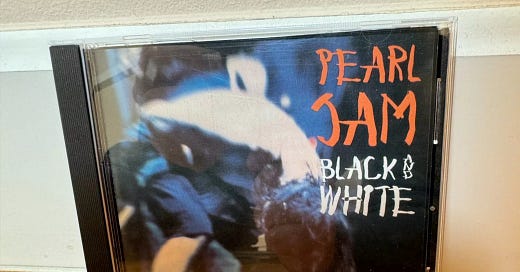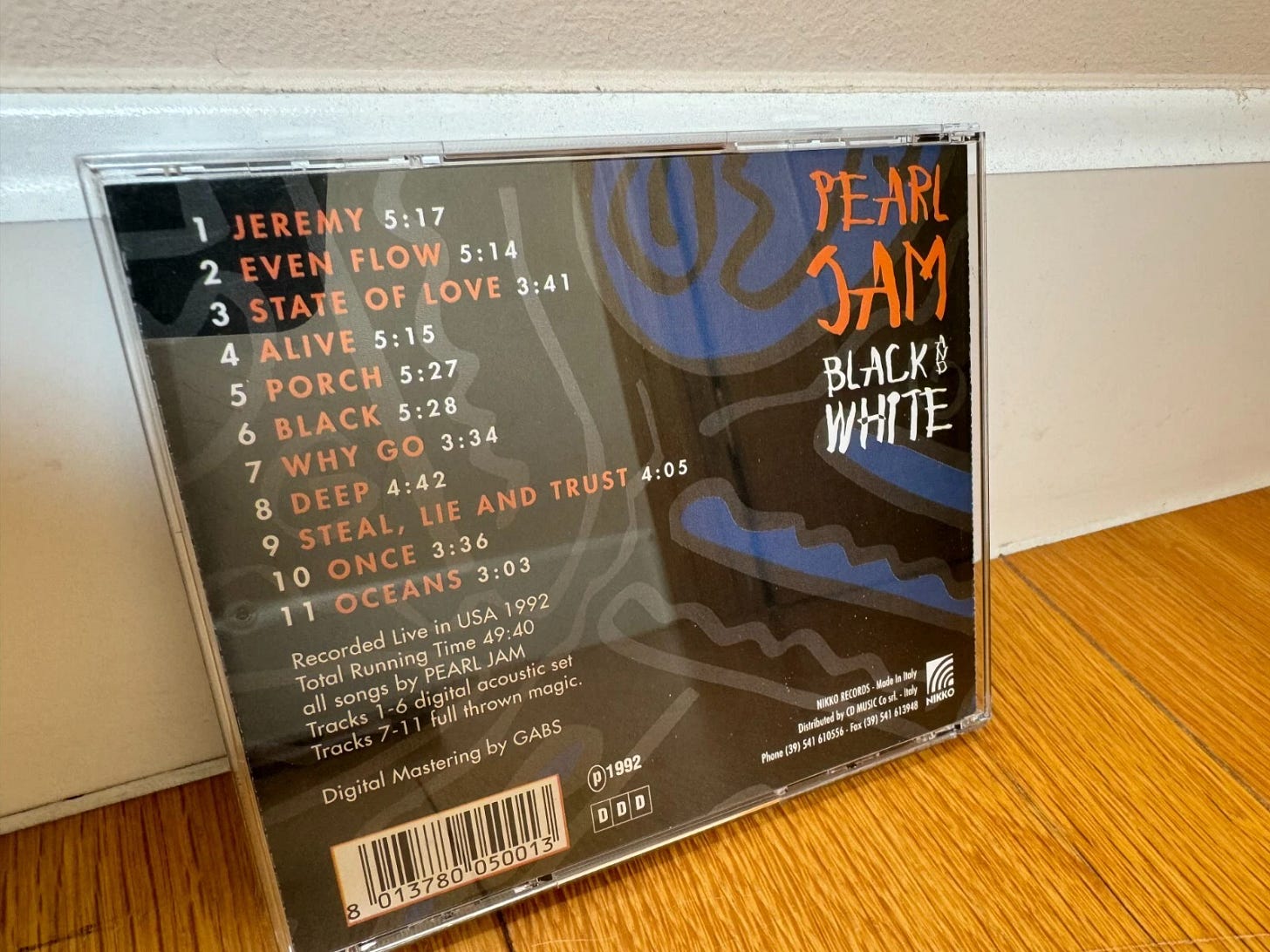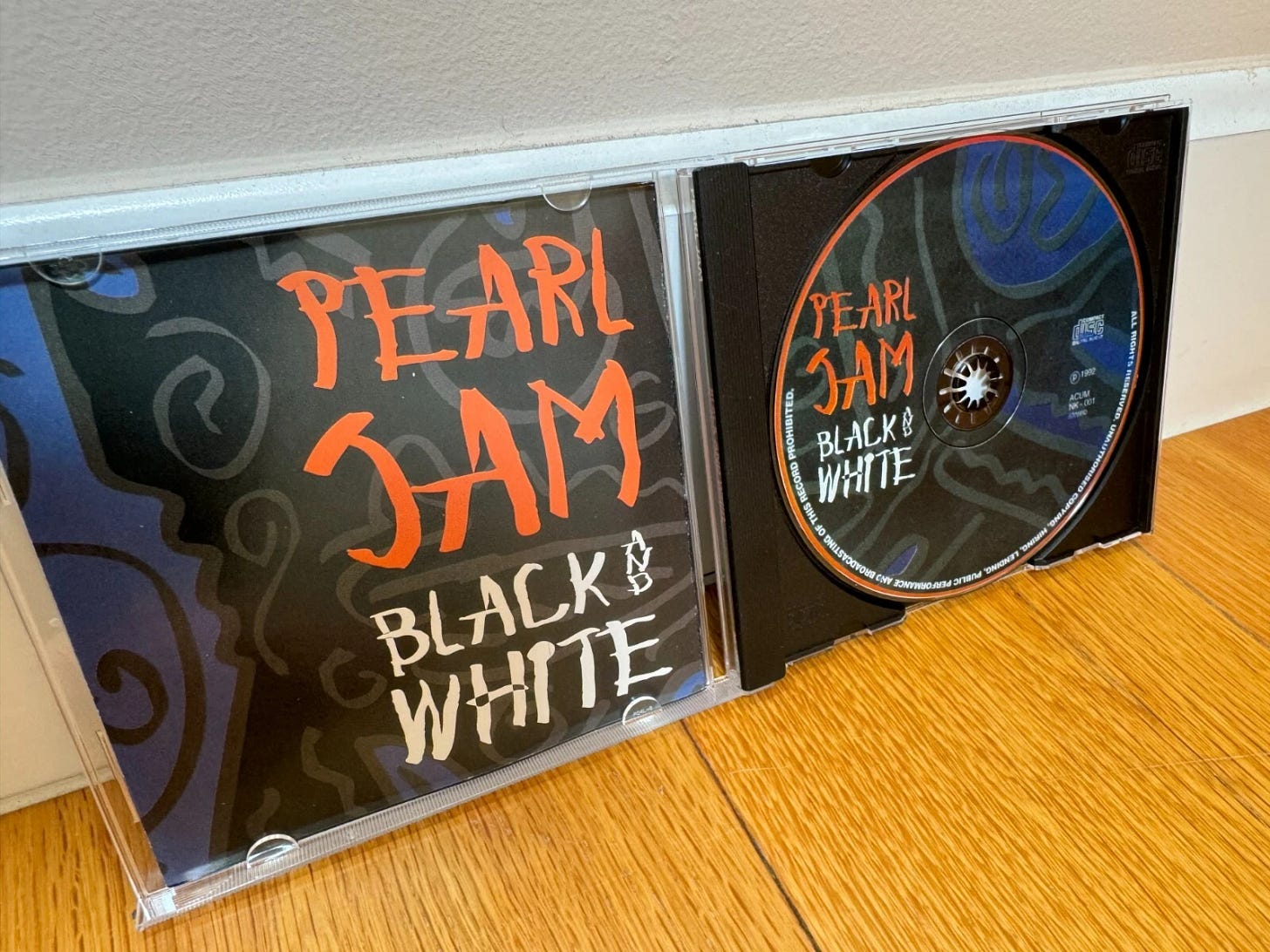Black and White Bootleg CD - Pearl Jam | 50 Albums in 50 Years
Imported, Mislabeled, and Completely Essential
“There's somethin… / There's somethin' I don't mind / There's a choice / In our time / I don't believe in / Changin' that / I could try / To make a change for real / There is somethin'... / To debate / I know I want... this / I want to live / I want to choose……
“Hey-ay-ay-ay / Hey-ay-ay-ay / Yeah / Yeah Yeah, yeah, yeah yeah, woah.”
In 1992 and 1993, the places me and my friends hung out were pretty simple: Burger King on 7th Ave, Lindale Mall, and Relics Records. But, Relics Records was key. I was introduced my buddy Thad. Once he introduced me I wanted to go there all the time. Sometimes we’d hang out for an hour and buy nothing. Just talk about music, flip through bootleg binders, read the back of an import CD like it was a sacred scroll. The bootlegs were usually in thick plastic sleeves or inside big black binders, You’d flip slowly through each page, squinting at blurry cover photos, badly translated track listings, and live shots that looked like they were taken on a disposable camera in a thunderstorm. Some had full tracklists with dates and locations, others just had vague song titles and mystery. You picked based on the artwork, the setlist, the hope that maybe this one would be the one. A particularly great version of 'Alive' or 'Release' could make the whole thing worth it—even if three other songs sounded like they were recorded in a garbage can. The moment you walked in, it smelled like incense. Jerry or Erin would be behind the counter, and they’d say hey like we were regulars. Because we were. We were there constantly.
Back then, the real score wasn’t the newest album that everyone already had. It was the stuff that felt underground—the imports, the live stuff, the bootlegs. Imports were usually international releases with bonus tracks, alternate artwork, or versions you couldn’t get at Best Buy. And bootlegs? They were unofficial live recordings—raw, rough, often mislabeled, but full of energy. They weren’t polished. They were for people who wanted to go deeper. And for me, that always meant Pearl Jam.
These things weren’t cheap. Thirty to fifty bucks a pop in early '90s money—which is like $75 to $100 now. And I bought a lot of them. Easily dropped over a grand on Pearl Jam bootlegs in the '90s, no question. Sounds ridiculous now, but back then it felt like the most logical thing in the world. It wasn’t just collecting—it was a way for me to dig deeper into my favorite band. To explore every version, every performance, every messy, mislabeled, live-wire moment. I wanted to know everything I could about Pearl Jam.
I grabbed Black and White at Relics somewhere between spring and fall '92. The cover kinda looked official if you didn’t know what you were looking at—just 'Pearl Jam' in blocky white letters over a grainy photo of Eddie doing his thing on stage. On the back it had a full tracklist with song titles and run times, a barcode, even little labels like "Digital acoustic set" and "Full thrown magic." Like, what does that even mean? But it had just enough polish to make you think it was legit—until you looked closer.
The first half of the CD was most of the Unplugged set—though for some reason, not the whole thing. Then it pivoted into a bunch of electric tracks that were clearly from a totally different show, maybe Chicago? No clue. One of them was labeled "Steal, Lie, and Trust," which was just someone guessing wrong at "State of Love and Trust." But it didn’t matter—we knew what it was. And actually, until the Singles soundtrack came out that summer, this bootleg was the only way to hear "State of Love and Trust" at all. That probably explains why it showed up twice on the CD—once unplugged, once electric. And honestly, that kinda made it better.
What made Black and White special was that, for years, it was the only way to hear Pearl Jam’s MTV Unplugged set. No YouTube, no streaming, no official release. If you wanted that performance, this bootleg was it. And you wanted it for Porch.
I’ve written about this before—in my Best Song Ever piece, and again [on Facebook in 2021]—because that version of “Porch” is unforgettable. Eddie scribbling “PRO-CHOICE” on his arm. That mumbled "1-2-3-4" at the beginning—you can barely hear it—but it’s loaded. It’s quiet, but there’s so much energy under it. You can feel it rumbling before the song even takes off. That totally unhinged last minute or so where Eddie just loses it. You can hear it in his voice, but if you’ve seen it, you know—his whole body is in it. It’s not just performance. It’s possession. I have a vivid memory of being in my parents’ Lumina minivan, blasting that version, screaming along with Eddie—“YEAHHHHHHH!”—totally lost in it. Just a teenager, yelling into the void with the windows up. It was catharsis. It was connection. And this bootleg let you feel that moment again and again.
And honestly, the whole Unplugged set is killer. The version of "Black" still gets me—that raw, cracked-open vocal from Eddie that just sits with you. And that stripped-down "State of Love and Trust"? Might be my favorite version of the song, ever. It’s tight, it’s urgent, and it somehow hits even harder without the distortion. The whole thing wasn’t some mellow acoustic session. It was Pearl Jam turning everything down and still managing to burn the place down.
Now, of course, I can just pull up ‘Porch (Unplugged)’ on Spotify in two seconds. And yeah, it still hits. But there was something about earning it back then. The waiting. The mystery. The effort. Today, people have access to all these high-quality videos from a random fan’s phone. But back in the day, it took real work to hear these shows. The recordings didn’t just appear—you needed the tapers. These people would sneak in mics, record on DATs, and quietly pass their stuff around. Then you had to find it. Trade for it. Pay for it. Half the time the sound was garbage—but sometimes, if you were lucky, you'd get a version that made the hairs on your arm stand up. And when that happened, it felt like you’d uncovered treasure.
I didn’t see Pearl Jam live until 1998 in Sacramento. I was supposed to go to Alpine Valley that summer, but I had an internship in the Bay Area and couldn’t make it work. So Sacramento was my first real show—and it was everything and nothing like the bootlegs. The sound was bigger. The crowd was wilder. But emotionally? I felt like I already knew what was coming. I’d been preparing. Studying. Feeling it in my bones for years thanks to discs like Black and White. These bootlegs didn’t just deepen my love for the band. They were the reason I fell in love with live music in the first place.
And it wasn’t just about owning the CDs. It was about sharing them. You’d bring the newest one over to a friend’s house. Play Porch at full volume. Pop it in the boombox CD player, crank the volume, and just let it rip. Sit there nodding like, "Yep. This is it."
The more we listened, the more we started to notice there were others like us. People who were into the bootlegs, who talked about the different versions, who laughed when a track was labeled wrong because yeah, we already knew what it really was. There wasn’t some big club, but you could feel the beginnings of something. A community forming in the background—slowly, quietly, through these weird little CDs.
Black and White was the one that cracked it all open for me. The bootlegs. The live thing. The obsession. The community.
And I’m still grateful to Jerry and Erin for having it. For making Relics feel like home. For helping a 16-year-old kid in Iowa discover something that would go on to shape his entire relationship with music.
Black and White wasn’t and still isn't official. But for me? It is absolutely, undeniably canon.






I was at that 1998 Sac show, too. That was the one with the Flag Burning speech in "RitFW," right?